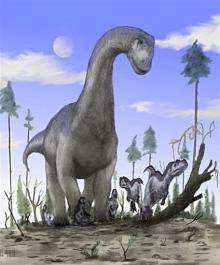Long-necked dinos didn't reach for the skies

A fondly-held belief about long-necked sauropods, the giant four-footed dinosaurs beloved of monster movies and children, is most probably untrue, a dino expert said on Wednesday.
At the zenith of the dinosaurs' reign, some sauropods evolved necks of extraordinary length -- more than nine metres (29.25 feet) in the case of the Mamenchisaurus, a titan of the Late Jurassic period around 150 million years ago.
Prevailing wisdom has it that these leviathans used their necks like giraffes today. They reached up high into the trees, munching leisurely on forest canopy that was out of reach for rival herbivores.
Not so, says a paper appearing in Biology Letters, a journal published by Britain's prestigious Royal Society.
It argues that giant sauropods most probably preferred to feed horizontally, rather than vertically, on the grounds of energy cost.
Australian evolutionary biologist Roger Seymour did a simulation of how much blood pressure a gigantic sauropod would need in order to place its head vertically.
He then calculated how much energy the creature would require in order to pump around blood at this high pressure.
"It would have required the animal to expend approximately half of its energy intake just to circulate the blood," says Seymour.
"A vertical neck would have required a high systemic arterial blood pressure. It is therefore energetically more feasible to have used a more or less horizontal neck to enable wide browsing while keeping blood pressure low."
Other dino specialists have likewise argued that long-necked sauropods were unlikely to have had a heart that was big enough to enable it to feed vertically for much of the time.
The Barosaurus -- whose neck put it in the same category of length as the Mamenchisaurus -- would have needed a heart weighing five percent of its bodyweight to pump blood to neck muscles and brain for craning upwards, according to a 2000 study.
(c) 2009 AFP
















